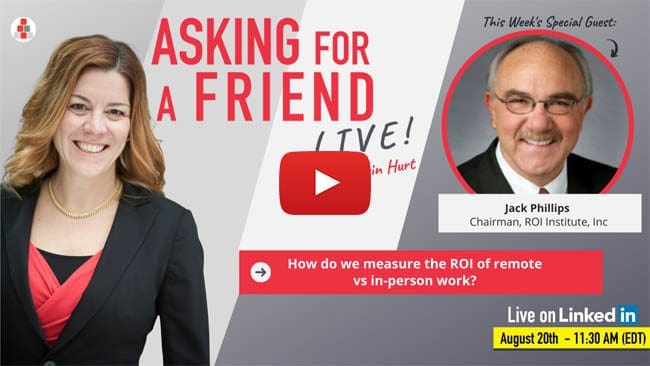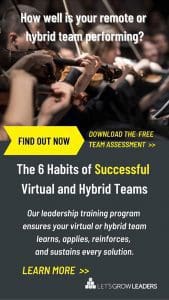Calculate ROI For a More Strategic Transition to Remote Teams
Your finance team did a bit of quick math to calculate ROI for making the transition to remote teams permanent based on real-estate savings and reduced commute times. But, you know it’s more complicated than that.
So how do you take a more comprehensive approach to measure the ROI?
Beyond the Past Pivot
If you’re like so many of our clients, the pandemic caused you to pivot fast to remote work and virtual teams.
You’ve got a long list of pros and cons and anecdotal ROI calculations.
Some employees love it.
Some hate it.
Managers and employees are telling you they’re way more productive. And others can’t wait to get back in the office for a more focused work environment.
So where do you start? How do you truly measure the ROI of remote vs. in-person work?
In this episode of Asking For a Friend, I talk with Jack Phillips, author of High-Impact Human Capital Strategy and Chairman of ROI Institute about how to calculate ROI for remote work vs. in-person work.
Karin Hurt Talks with Jack Phillips About a Strategic Approach to Calculate ROI

1:30 More details about Jack Phillip’s approach to calculating ROI.
2:55 A case study published by SHRM of an insurance company that allowed claims processors and claims examiners to work from home (before the pandemic.)
3:40 Companies are asking how to know what is better for the company and the employees now that there is a choice in the work location. (Office, home, hybrid)
4:16 What are key areas to look at to calculate ROI of remote work?
- 4:20 Reaction: How do people (employees and managers) see this situation?
- 5:08 Learning: the rules for working at home and how to work remotely, measuring by self-assessments, quizzing, or observation.
- 6:27 Application: is it working? Are we following processes? Are we able to manage well?
- 7:20 Impact: What are tangible measures (to covert to money, i.e. savings in office expense), retention levels, and productivity levels. Are there fewer distractions, less stress, and more effort expended to help guarantee the remote option continues? Other items to consider are a reduction in absenteeism and sick days.
9:20 What are intangible measures such as lower stress, convenience, money savings for employees?
10:15 Karin: Have all of your studies shown that remote work results in higher ROI? Jack: so far, yes.
11:40 Karin: Are there any downsides?
12:00 Jack: Yes. Teamwork, collaboration, and engagement can go down. Mental health issues because of isolation can increase. Career issues may occur. Knowing these in advance helps you manage these possibilities.
13:58 There are distractions from home as well (i.e. pets, kids, etc) that a company will need to address (particularly if schools go remote, etc.) Policies during the pandemic may not be how they need to run their remote work all the time.
16:20 A discussion of the case study occurring prior to the pandemic.
17:20 The manager makes a key difference.
17:48 There is the possibility of resistance from managers because some are under the impression they have to see workers. There is also an insecurity that their jobs may not be needed.
19:29 For your organization: get a study of the ROI of remote work that includes 1) ROI for executives (make it a credible analysis) 2) ROI from employees through intangibles/viewpoints and 3) help to the environment as that is often a value that companies want to embrace. Profits, people, planet.
23:06 More about the case study. Even with expenses that the company incurred to set people up at home (buildout, technology), the company saw a positive ROI.
26:04 Karin: How do you calculate ROI when it comes to innovation?
26:24 Jack: Work from home can get in the way of engagement. The more engaged, the more innovation. Companies need a foundation that encourages innovation to begin with, whether or not they have remote workers.
27:54 Last bit of advice: it takes effort but it doesn’t too take long to collect the right type of data to help you determine the ROI of remote work for your company. Review the case study. Be proactive and do something.
Your turn. What would you add? How are you calculating ROI for your move to virtual and hybrid teams?








0 Comments